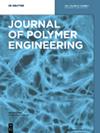Fabrication of ultrafiltration membranes based on methacrylate copolymers containing quaternary ammonium and PEG units for dye removal
IF 1.7
4区 工程技术
Q4 POLYMER SCIENCE
引用次数: 0
Abstract
Phase inversion involves in a complex process due to numerous factors affecting the membrane formation. Among them, polymer chain entanglement from polymeric membrane materials plays a critical role in regulating membrane structure and is still worth further exploration. Herein, a series of methacrylate copolymers with different contents of poly(ethylene glycol) methacrylate (PEGMA) were designed and synthesized, and ultrafiltration membranes cast from these copolymers were systematically investigated regarding structural evolution and filtration performance. Surface zeta potential of membranes gradually transformed from positive to negative with the increasing PEGMA content due to nonsolvent-induced surface migration of element oxygen, and meanwhile the transformation from finger-like pore structure to sponge-like pore structure in the support layer was observed, which could be attributed to chain entanglement of the PEGMA-rich copolymer. Filtration experiments indicated that sponge-like membranes possessed better separation effect of Victoria blue B compared with finger-like membranes, and the optimized mPP40-15 % showed a retention rate of 99.55 % and permeance of 110.26 L m基于含有季铵和 PEG 单元的甲基丙烯酸酯共聚物的超滤膜的制作,用于去除染料
由于影响膜形成的因素众多,相位反转是一个复杂的过程。其中,高分子膜材料的聚合物链缠结在调节膜结构方面起着关键作用,仍值得进一步探讨。本文设计合成了一系列不同含量的聚乙二醇甲基丙烯酸酯(PEGMA)共聚物,并系统研究了这些共聚物浇铸的超滤膜的结构演变和过滤性能。随着 PEGMA 含量的增加,膜的表面 zeta 电位逐渐由正变负,这是由于非溶剂引起的氧元素表面迁移所致,同时还观察到支撑层中的指状孔隙结构向海绵状孔隙结构的转变,这可能是由于富含 PEGMA 的共聚物的链缠结所致。过滤实验表明,与指状膜相比,海绵状膜具有更好的维多利亚蓝 B 分离效果,优化后的 mPP40-15 % 的截留率为 99.55 %,渗透率为 110.26 L m-2 h-1 bar-1,对染料/盐混合物具有良好的选择性分离效果。此外,海绵状膜还具有易于再生、防污和过滤稳定的特点。这项工作将为调节膜结构提供指导,并为处理染料废水的膜分离提供一种替代材料。
本文章由计算机程序翻译,如有差异,请以英文原文为准。
求助全文
约1分钟内获得全文
求助全文
来源期刊

Journal of Polymer Engineering
工程技术-高分子科学
CiteScore
3.20
自引率
5.00%
发文量
95
审稿时长
2.5 months
期刊介绍:
Journal of Polymer Engineering publishes reviews, original basic and applied research contributions as well as recent technological developments in polymer engineering. Polymer engineering is a strongly interdisciplinary field and papers published by the journal may span areas such as polymer physics, polymer processing and engineering of polymer-based materials and their applications. The editors and the publisher are committed to high quality standards and rapid handling of the peer review and publication processes.
 求助内容:
求助内容: 应助结果提醒方式:
应助结果提醒方式:


